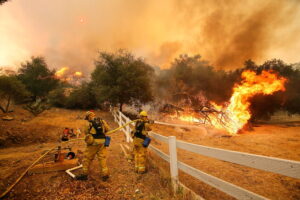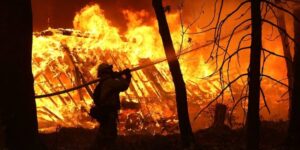Tag: California
Bursting the PC Bubble: California Wildfires Continue to Run Rampant
by The Cowl Editor on October 31, 2019
National and Global News
by Kyle Burgess ’21
News Staff
Thousands of California residents have found themselves on the move as sweeping wildfires continue to engulf both ends of the state. This recent string of wildfires comes after a relatively quiet year in which no major wildfires occurred from May through mid-September, the typical California wildfire-causing dry season.
The tinder box conditions that breed such fires are the result of extremely dry summers that turn trees and leaves into fuel as well as strong winds which spread the fires across entire forests at a rapid pace. This process has been exacerbated by historically-strong winds throughout California as well as human involvement, with fallen power lines possibly to blame for two of the most recent fires.
Pacific Gas and Electric Co. (PG&E) admitted that power lines may have started two wildfires over the weekend in the San Francisco Bay Area, causing widespread electrical blackouts to prevent their spread by further fallen power lines in the face of high winds.
PG&E also reported to state regulators that these fires “match blazes that destroyed a tennis club and forced evacuations in Lafayette, about 20 miles east of San Francisco.”
Per CNBC, “at least 900,000 power customers…were in the dark at the height of the latest planned blackout, nearly all of them in PG&E’s territory in northern and central California.” Less than half of these customers had their services restored by this past Monday, with some 1.5 million people in 29 counties expected to experience their own blackouts in anticipation of strong winds.
At the same time, the Kincade Fire in Northern California continued to spread, covering a new total of 75,000 acres with firemen only able to contain 15 percent of the blaze. One spokesperson for Cal Fire, the California Department of Forestry and Fire Protection, claimed that it would take “weeks, if not months” to battle back the flames.
Some 180,000 people have been ordered to leave their homes in anticipation of Kincade’s flames, with the roads around Santa Rosa, CA packed bumper to bumper with cars trying to flee. High winds bringing gusts of more than 102 mph have fanned destruction across Sonoma, as 3,000 people continue to battle the blaze that has already destroyed nearly 400 structures, including the 150-year-old Soda Rock Winery.
The fires’ rapid pace and direction is difficult to predict, with some residents getting short or even limited notice of their paths. One BBC correspondent who quickly found himself in the way of The Tick Fire near Santa Clarita noted, that “My partner was in the house and had just seconds to get out, to pick up the dog, throw the dog in the car—gently—just get out. It happened that quickly and all our neighbors did exactly the same thing.”
Meanwhile, another fire threatens to engulf the famous Getty Center just outside of Los Angeles. The Getty Fire has so far covered 618 acres and destroyed eight structures, according to Los Angeles Mayor Eric Garcetti. The blaze, which was only 5 percent contained, also partially destroyed six other structures. An investigation into possible causes of the fire are currently underway. Arson has not been ruled out.
In addition to the Getty Center itself, many high-end homes in the Los Angeles area are at risk to the wide-sweeping flames, prompting further evacuations. Celebrities such as LeBron James were evacuated from their houses along with students of Mount Saint Mary’s University near UCLA.
As firefighters continue to slowly keep the blazes under control across the state, the destruction left in the fires’ wakes has prompted California Governor Gavin Newsom to declare a state-wide emergency as 43 of California’s 58 counties are under “red flag” warnings with ideal conditions for the flames to spread.

photo courtesy of flickr.com
Bursting the PC Bubble: California Copes with Destructive Wildfires
by The Cowl Editor on November 29, 2018
National and Global News
by Malena Aylwin ’22
News Staff
In the past 13 months, California has seen two of its largest wildfires in terms of acreage, two of its most destructive blazes in terms of structures lost, and the deadliest fire on record, which has claimed at least 88 lives.
California is battling around 17 substantial fires including the biggest in the state’s written history. Since the beginning of California’s fire season, there have been multiple fires, and compared to the quantity of land burnt over a similar period a year ago, the state has employed more fire-fighting efforts than ever.
The Northern California city of Paradise is gone—the Camp Fire, by far the deadliest and most destructive wildfire in state history, has reduced homes to ashes. It conjures images of a tsunami of flames tearing through the town, destroying everything in its path.
Over the past few decades, cities in California have crept closer and closer to fire-prone forests. Codes went lax, and many homes were still getting built with wooden shingles.
There were more than 158 individuals still missing in the Butte County fire zones, and experts were attempting to track them down. Authorities requested that occupants go to the Butte County Sheriff’s Department’s site to check the missing persons’ list to ensure they are not on it.
The numbers, however, do not even begin to describe the challenge and intricacies of fighting these fires. Such struggles include the temperatures of the land that rescue teams must face due to the fires. Flames are moving more quickly than anybody has ever observed, and boundaries that in years past contained flames — bulldozer lines, highways, streams — are no match for the fires. As the days go on, the numbers have climbed, as more sections of land are consumed and more workforce hurry to the fires.
Part of the problem is climate change. Autumn has grown increasingly dry in California, which is poorly timed with hot, dry seasonal winds that tear in from the east, further desiccating vegetation and turbo-charging wildfires.
Reporters later asked President Trump if seeing what survived of the Northern California town and strolling among the ashes made him reconsider his sentiment on climate change — that it is a deception, counterfeit news, or essentially nonexistent. “No,” Trump replied. Rather, he placed blame on California forest management.
More than 30 homes in the gated Ventura County community were lost. Some people were protected by both county firefighters and private crews who are covered by their homeowner’s insurance policy. With California encountering two years of uncommonly fierce blazes, the state has been left with an excess of 20,000 homes obliterated and hundreds of thousands dead.
Because fires have become such a constant issue, the private firefighting business is booming. These brigades work freely from area firefighters; their job is to protect specific homes under contract with insurance agencies.
Others are trying to raise funds, such as Stevie Wonder, who is having a benefit concert for California fire victims. Others, like Miley Cyrus and Liam Hemsworth, have donated to help those affected by the fires.
Although Californian rescue teams and government officials are working as quickly as they can to combat with these natural disasters, time will only tell how quickly the environment will be able to recover.
Bursting the PC Bubble: California Copes with Destructive Wildfires
by The Cowl Editor on November 29, 2018
National and Global News
by Malena Aylwin ’22
News Staff
In the past 13 months, California has seen two of its largest wildfires in terms of acreage, two of its most destructive blazes in terms of structures lost, and the deadliest fire on record, which has claimed at least 88 lives.
California is battling around 17 substantial fires including the biggest in the state’s written history. Since the beginning of California’s fire season, there have been multiple fires, and compared to the quantity of land burnt over a similar period a year ago, the state has employed more fire-fighting efforts than ever.
The Northern California city of Paradise is gone—the Camp Fire, by far the deadliest and most destructive wildfire in state history, has reduced homes to ashes. It conjures images of a tsunami of flames tearing through the town, destroying everything in its path.
Over the past few decades, cities in California have crept closer and closer to fire-prone forests. Codes went lax, and many homes were still getting built with wooden shingles.
There were more than 158 individuals still missing in the Butte County fire zones, and experts were attempting to track them down. Authorities requested that occupants go to the Butte County Sheriff’s Department’s site to check the missing persons’ list to ensure they are not on it.
The numbers, however, do not even begin to describe the challenge and intricacies of fighting these fires. Such struggles include the temperatures of the land that rescue teams must face due to the fires. Flames are moving more quickly than anybody has ever observed, and boundaries that in years past contained flames — bulldozer lines, highways, streams — are no match for the fires. As the days go on, the numbers have climbed, as more sections of land are consumed and more workforce hurry to the fires.
Part of the problem is climate change. Autumn has grown increasingly dry in California, which is poorly timed with hot, dry seasonal winds that tear in from the east, further desiccating vegetation and turbo-charging wildfires.
Reporters later asked President Trump if seeing what survived of the Northern California town and strolling among the ashes made him reconsider his sentiment on climate change — that it is a deception, counterfeit news, or essentially nonexistent. “No,” Trump replied. Rather, he placed blame on California forest management.
More than 30 homes in the gated Ventura County community were lost. Some people were protected by both county firefighters and private crews who are covered by their homeowner’s insurance policy. With California encountering two years of uncommonly fierce blazes, the state has been left with an excess of 20,000 homes obliterated and hundreds of thousands dead.
Because fires have become such a constant issue, the private firefighting business is booming. These brigades work freely from area firefighters; their job is to protect specific homes under contract with insurance agencies.
Others are trying to raise funds, such as Stevie Wonder, who is having a benefit concert for California fire victims. Others, like Miley Cyrus and Liam Hemsworth, have donated to help those affected by the fires.
Although Californian rescue teams and government officials are working as quickly as they can to combat with these natural disasters, time will only tell how quickly the environment will be able to recover.

